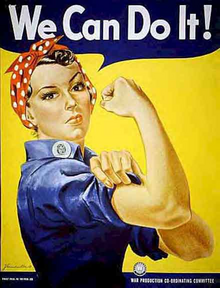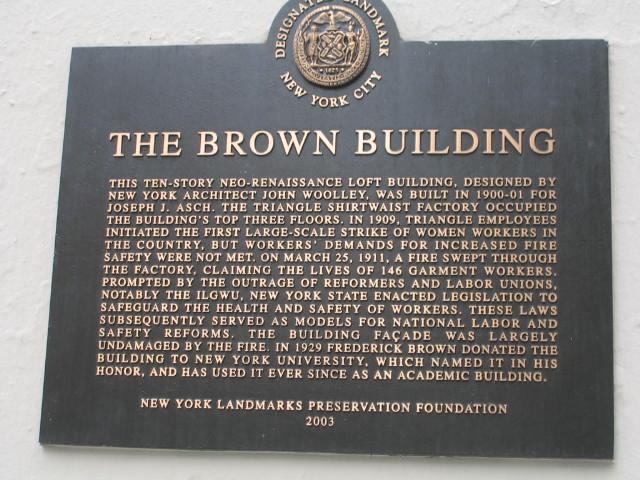This is adapted from something I wrote some years ago when I actually worked in the building where the Triangle Shirtwaist fire took place. But it is a part of American history, labor history, and Jewish-American history. And we must not EVER forget because the women who lost their life that day died so that today we have fire regulations and unions.
On March 25th 1911, 146 people died in the very building I used to work in before our lab moved to the NYU school of medicine. The result of their deaths was the rapid growth of the International Ladies' Garment Workers' Union and the real beginning of the fight against sweatshops. It also was the beginning of fire regulations in American cities.
The story of the fire and the missed opportunities to prevent it are chilling.

Several years ago I worked in what is now known as the Brown Building at NYU near Washington Square. But in 1911 it was the Asch building. The top three floors of the Asch building comprised the Triangle Shirtwaist Factory. For the record, a shirtwaist is essentially a woman's blouse. I worked a couple of floors below where the factory was. Each March 25th I could look out of my lab's window and see the annual commemoration of those who died in 1911.
This factory employed some 500 workers, mostly young women immigrants. The working conditions were essentially sweatshop conditions with fourteen-hour workdays and a 60- to 72-hour work week. This is what work conditions were often like BEFORE unions. The factory was also a death trap because there were hardly any fire regulations. Workers of course smoked and lighting was from gas lighting...and, of course, the clothing was flammable. But it was even worse due to management distrust of the workers. One of the two exit stairs was locked to keep workers from taking breaks. The fire escape was substandard. And working conditions were crowded. This is the kind of situation unions fought so hard to fix.
A couple of years before the fire, in 1909, a walkout by the Triangle Shirtwaist Factory workers sparked a large-scale labor protest, called the uprising of 20,000. When the management of the Triangle Shirtwaist Factory locked out its striking employees, it inspired a series of meetings of the industry's workers, leading to a much larger-scale walkout. Since a majority of the workers were Jewish immigrants, the large-scale action began with a Yiddish oath, that, roughly translated, means "if I break my oath may my hand wither away." Twenty thousand garment workers walked out for fourteen weeks. This was before the right to strike was guaranteed. They were risking their livelihood, and in some cases their very lives, to fight for better conditions.
All of the usual thuggery by management that typified the early labor movement was manifest. With police assistance, management hired thugs to beat up the striking women. But the strike continued, Yiddish oaths and all. An agreement was eventually reached, and, after an even larger strike in 1910, the International Ladies' Garment Workers' Union was recognized. It was a MAJOR victory for working class Americans.
But the Triangle Shirtwaist Factory refused to sign the agreement and conditions there scarcely improved.
On March 25, 1911, a fire began two floors above where I worked so many years later. Workers on the tenth floor were alerted and escaped. But workers on the 9th floor were not. When the fire reached them, workers found doors locked by management. Some jumped out of windows to their deaths to escape the fire, an image that took on new meaning for me on 9/11 when many did the same at the much higher World Trade Center. Watching that happen, I found it overwhelming to imagine making the choice to jump. Other women jumped down the elevator shaft...mostly to their deaths. Others were overcome by smoke.
The rush of workers down the inadequate fire escape led to more deaths when the fire escape collapsed. When the fire department arrived, they found that their ladders were too short to reach above the 6th floor.
In all 146 people died. Of those, 54 died jumping out of windows to escape the fire. You can read an eyewitness account of the fire here. It is somewhat disturbing especially after 9/11 because of the description of the falling bodies. Here is the most touching excerpt:
As I looked up I saw a love affair in the midst of all the horror. A young man helped a girl to the window sill. Then he held her out, deliberately away from the building and let her drop. He seemed cool and calculating. He held out a second girl the same way and let her drop. Then he held out a third girl who did not resist. I noticed that. They were as unresisting as if he were helping them onto a streetcar instead of into eternity. Undoubtedly he saw that a terrible death awaited them in the flames, and his was only a terrible chivalry.
Then came the love amid the flames. He brought another girl to the window. Those of us who were looking saw her put her arms about him and kiss him. Then he held her out into space and dropped her. But quick as a flash he was on the window sill himself. His coat fluttered upward--the air filled his trouser legs. I could see that he wore tan shoes and hose. His hat remained on his head.
Some 100,000 people attended the funeral of these victims. The factory owners were put on trial but acquitted. But the incident radicalized the union movement, making their struggle a matter of life and death. When you hear people complain about unions, go back and re-read that eyewitness account of the fire and remember why the union movement began in the first place. I can personally tell you some complaints about certain unions and certain union members...but overall, anyone who knows the history of labor in America KNOWS that unions are the salvation of working class Americans.

(picture from this site)
The eyewitness account of the fire ends thus:
The floods of water from the firemen's hose that ran into the gutter were actually stained red with blood. I looked upon the heap of dead bodies and I remembered these girls were the shirtwaist makers. I remembered their great strike of last year in which these same girls had demanded more sanitary conditions and more safety precautions in the shops. These dead bodies were the answer.

(picture from this site)
My great-grandfather was a furniture maker who emigrated from Russia around the time of the anti-Jewish pogroms. He worked in a factory in Milwaukee, Wisconsin. In that factory he lost two fingers and an eye in separate accidents. This was before the union movement. It is because of the union movement that such accidents are far, far less common.
The Asch building was bought by NYU and is now the Brown Building which, in turn, was joined up with two other buildings to be come the Silver Center, one of the main buildings of the university. A plaque remains on the Brown building commemorating the fire.

(image from this site)
I will end by mentioning that the successor to the International Ladies' Garment Workers' Union is the Union UNITE HERE which includes garment and hotel workers.
Return to Mole's History Page.
Return to I Had a Thought
Keep the balls rolling!! Nice posts you have given for us.booking fees
ReplyDeleteI feel happiness to read the content that you are posting.
ReplyDeletehotel comparison websites